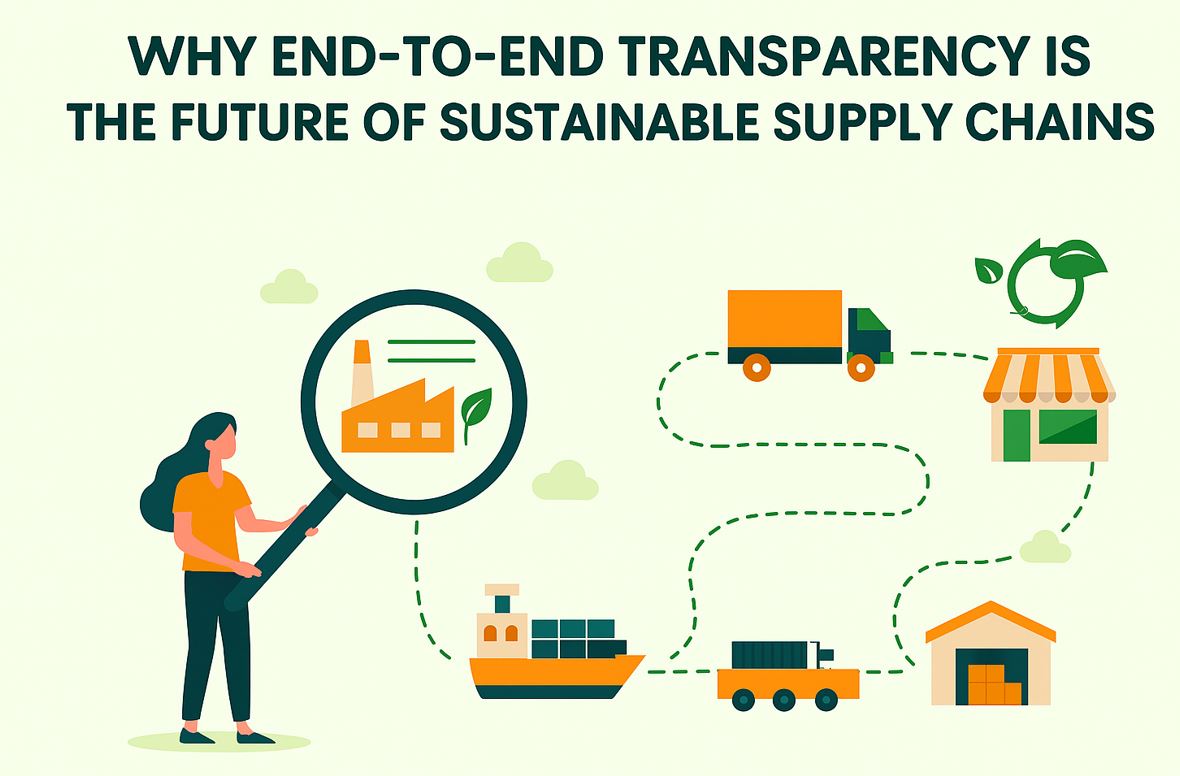Sustainability is the foundation of our current global economy. Consumers, investors, and governments now demand visibility. They want to know how products are sourced, manufactured, and delivered. Nothing is hidden anymore. End-to-end transparency has become important for building trust. Only transparent brands have loyal customer bases. Transparency ensures ethical practices. It also directs brands in meeting environmental standards in modern supply chains.
But the question is, why is transparency vital for sustainability? We will walk you through the details to answer this. We will also unravel how technology is reshaping supply visibility. You will also learn what actionable steps you can take to future-proof your supply chains.
What Does End-to-End Transparency Really Mean in Supply Chains?
End-to-end transparency is the ability to view every step of the supply chain in full and in real time. It refers to all stages, from the location of the raw materials to delivering the finished goods. It allows companies to monitor moral labor practices, keep track of effects on the environment, and identify inefficiencies.
According to the World Economic Forum, more than 70% of a company’s sustainability impact comes from its supply chain. Without transparency, it is virtually impossible to measure or reduce this damage. Transparency enables better collaboration between manufacturers, retailers, and suppliers. Fair trade and responsible manufacturing are assured.
Why Is Transparency Crucial for Sustainable Supply Chains?
Sustainability and transparency go hand-in-hand. How can consumers ensure ethical sourcing or carbon reduction goals without open access to information? If your audience doesn’t know about your actions, there’s no truth to your claims. Give them open access to information, so you can back your claims with evidence. Transparency enables accountability and builds consumer trust. It also helps brands with regulatory compliance.
- Companies can verify environmental claims and reduce greenwashing.
- Modern consumers value honesty. They want to know how and where products are made.
- Governments are introducing stricter sustainability reporting standards.
- Tracking materials and logistics helps minimize waste and delays.
Companies need to make transparency a part of their culture. Such a culture transforms sustainability from a compliance task into a value-driven strategy.
How Technology Is Driving Transparency in Supply Chains
Technology has taken over everything. This transformation has made supply chain transparency more achievable than ever before. Blockchain, IoT, AI, cloud analytics, and similar technologies provide very effective tools. They can collect, share, and verify data at every stage.
Blockchain for Traceability
Blockchain provides immutable digital records. They help companies trace the journey of a product from its origin to the shelf. Both Unilever and Nestlé use blockchain for tracking raw materials, including palm oil, which helps them ensure that suppliers adhere to specific sustainability standards.
IoT for Real-Time Monitoring
Sensors and smart devices track shipments, temperature, and environmental data. This reduces spoilage and optimizes logistics. It also provides continuous insight into sustainability performance.
AI for Predictive Insights
Artificial Intelligence analyzes large sets of data to identify inefficiencies. It is now capable of forecasting demand and identifying sustainability risks. For instance, AI can help predict where waste occurs. It could then recommend optimal transportation routes that lower emissions.
Cloud Collaboration Platforms
Cloud-based tools enable collaboration among suppliers, manufacturers, and retailers by providing real-time status. Shared dashboards enhance transparency. No more data silos, and decision-making has become better across the chain.

How Can Businesses Build a Transparent and Sustainable Supply Chain?
It’s important to understand the basics. Learning implementation of transparency is essential. Building transparency is a continuous process. It requires cooperation between suppliers, manufacturers, and even the end-users.
Here’s a step-by-step roadmap:
1. Map the Supply Chain
Identify all your suppliers, distributors, and logistics partners. Understanding the full scope of your supply network reveals hidden risks and inefficiencies.
2. Collect Reliable Data
Collect data on environmental, social, and governance performance. Back up the information with verified databases, digital tracking systems, and audits of various suppliers.
3. Engage Suppliers
Transparency is a two-way street. Educate and work with suppliers on the improvement of their sustainability practices. Offer training or incentives for compliance.
4. Leverage Digital Tools
Track progress and prevent fraud by using AI-driven analytics and blockchain tracking. Real-time visibility makes the process of detecting problems much easier to handle before they escalate.
5. Communicate with Consumers
Share sustainability reports and certifications publicly. Consumers appreciate honesty and will support a brand more even when sharing progress isn’t perfect.
What Are the Key Challenges in Achieving Transparency?
Transparency has many benefits. But nothing comes without challenges. Companies must address strategically.
Many organizations struggle with data fragmentation. It happens when different systems don’t communicate effectively. Another challenge is supplier resistance. Partners may hesitate to share sensitive information, which can hinder transparency in certain steps.
The cost of technology adoption is another barrier for many SMBs. Implementing blockchain or IoT requires an upfront investment. Most startups go for sponsors and investors. But that is also very difficult in such a competitive market.
Lack of global standards is another major challenge in the global market. Transparency requirements vary across regions and industries. Such variations in policies can build a lack of trust among global buyers.
Businesses can overcome these challenges. They should adopt unified digital platforms and establish clear data-sharing policies. Also, partner with certified sustainable suppliers. Partner with suppliers who practice sustainability.
Transparency in the Beauty and Packaging Industry
The cosmetics sector provides an excellent example of how transparency drives sustainability. Brands are now disclosing more about their products than ever. They clearly label ingredient origins and packaging sources. Even carbon footprints are shared with consumers. Many companies are embracing innovative cosmetic packaging trends. These include biodegradable materials, refillable containers, and much more. These trends help them meet consumer demand for cleaner beauty solutions.
Sustainable materials are a crucial step. Hence, it’s important to choose a packaging distributor who uses green materials. It gets even better if they offer packaging bottles wholesale. Choosing eco-friendly materials can ensure both quality and environmental responsibility at scale. This integration of transparency, technology, and eco-conscious packaging reflects a model that other industries can follow.
How Governments and Global Organizations Support Transparency?
International frameworks and policies are accelerating the push for supply chain visibility.
For instance:
- This means that the EU’s CSDDD calls upon companies to identify issues that include, but are not limited to, human rights and environmental issues within its supply chain.
- The U.S. Environmental Protection Agency (EPA) supports sustainable manufacturing through life-cycle assessment tools.
- The United Nations Global Compact urges all companies across the world to adopt responsible supply practices that are aligned with the Sustainable Development Goals.
These kinds of initiatives make transparency a global standard for ethical and sustainable growth.
Can Consumers Influence Transparent Supply Chains?
Absolutely! Consumers have a powerful voice. They can reshape entire sustainable practices. Transparency helps consumers make better decisions. They push brands toward accountability. Awareness alone can change entire industries. When you reward one brand for green efforts, others follow suit. They also get motivated to do the same and get rewarded.
Here’s how consumers contribute to this shift:
- Do your research before you buy: Check for independently verified sustainability certifications.
- Support transparent brands: Choose companies that disclose sourcing and labor practices.
- Share feedback on social media: Publicly praise transparency to encourage the brands to keep being transparent.
- Stay informed about regulations and global restrictions: Learn about global sustainability updates to identify greenwashing.
Actionable Steps for Businesses Moving Forward
Are you thinking about implementing new systems? Remember, transparency is about progress, not perfection. Start small and measure impact. Then scale what works. If your organization is ready to commit to transparency and sustainability, here are immediate steps you can take:
- Adopt sustainability auditing tools to monitor suppliers.
- Publish annual sustainability reports aligned with global standards.
- Integrate renewable materials in packaging and manufacturing.
- Invest in data-driven platforms for real-time visibility.
- Collaborate with NGOs for third-party verification and credibility.
Final Thoughts
The future of supply chains is transparent, ethical, and sustainable. As technology evolves and global awareness grows, companies that prioritize transparency will lead markets built on trust and accountability.
You can implement transparency in every step. The message is clear. Transparency is the foundation for a resilient and sustainable future.







